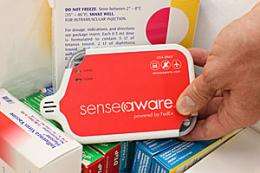Temperature tracking device for packages may have climate metrology applications

(PhysOrg.com) -- National Institute of Standards and Technology researchers are working to reduce the uncertainty associated with climate-change measurements using a mobile temperature-sensing technology made for tracking delicate or perishable, high-value packages in transit. Developed by international shipper FedEx and tested with help from NIST, the device connects to cell phone networks to provide users with near real-time information on the package’s precise location, temperature, humidity, pressure, acceleration, elevation and exposure to light.
Historically, package tracking has provided information to customers about a package’s route and anticipated delivery date and time. Seeking to provide customers with more information on the “vital signs” of their shipments, the company approached NIST about the feasibility of achieving accurate temperature measurements in a mobile device.
“The primary function of the device is to monitor temperature-sensitive materials such as medicines and vaccines, tissues, organs, blood, etc.,” says Greg Strouse, leader of NIST’s Temperature and Humidity Group. “We tested the beta units when they were transmitting information and when they were simply recording it, and we found that the devices create heat when transmitting, which throws off the measurement. To fix that, we developed performance data and an algorithm that kicks in to correct the temperature measurement when the device is actively communicating.”
Once all the kinks were ironed out, Strouse and his group worked with the National Voluntary Laboratory Accreditation Program (NVLAP), a NIST service that tests and accredits independent testing laboratories, to help the company find a capable, independent lab to test the devices en masse.
The result was a palm-sized device that a customer can place inside a package. The customer can monitor the transit of their package in real time through a Web-based interface. A GPS receiver in the device provides location information, and the device sends updates on its status wherever it can get a cell phone signal. It even monitors the shipments while aboard airplanes and transmits the data upon landing.
Accurate to within 0.02 degrees Celsius and able to send and store data for up to 30 days, the technology lent itself quite easily to another NIST project focused on measurements for climate change. The device’s connectivity and accuracy make it ideal for monitoring surface air temperature, which climate scientists often use to evaluate the performance of their models.
“Because continuous measurement can be more informative than daily minimum and maximum temperature observations, we’re looking into the potential for using these devices as prototype weather stations and comparing their results with the analog and digital style instruments used for weather observations,” says Strouse. “Our goals are to better understand and quantify the measurement uncertainty of both the historical analog and current digital measurement systems as well as improving the science base for metrology used in surface air temperature measurements.”
NIST is planning to station three of the devices at locations around the NIST campus in Gaithersburg, Md. The group intends to also erect a tower to mount one of the devices to better understand 3-D temperature gradient mapping strategies near the surface.
More information: For more information on the new technology, see www.senseaware.com
Provided by National Institute of Standards and Technology










.jpg)

.jpg)






